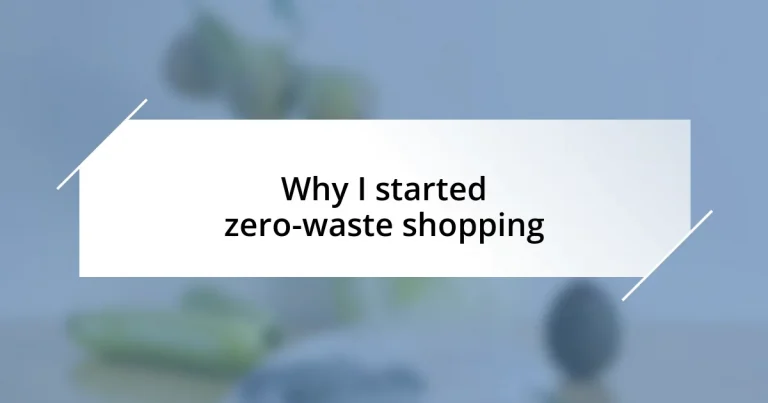Key takeaways:
- Adopting zero-waste shopping significantly reduces plastic waste and promotes environmental sustainability, while also fostering community connections and supporting local economies.
- The “five R’s” of the zero-waste lifestyle—refuse, reduce, reuse, recycle, and rot—provide a framework for mindful consumption and empower individuals to make intentional choices.
- Starting with zero-waste shopping involves planning, assessing regular purchases, and investing in reusable bags and containers to create a more intentional shopping experience.
- Common challenges include overwhelming options, social scrutiny when using reusable items, and finding reliable zero-waste resources; community support can help navigate these hurdles.

Reasons for choosing zero-waste shopping
One of the main reasons I chose zero-waste shopping is the impact it has on the environment. I remember the first time I really noticed the mountains of plastic waste we produce; it hit me during a beach cleanup. Seeing it all laid out, I realized that every piece I had ever tossed aside was contributing to this issue. Doesn’t it make you wonder where all that waste ends up?
Another compelling reason for me has been the connection to local communities. When I started shopping at bulk stores, I met inspiring individuals who felt as passionate about sustainability as I do. It felt amazing to know that my choices were supporting local farmers and artisans, rather than large corporations. Have you ever considered how your shopping habits can strengthen your community ties?
Lastly, zero-waste shopping encourages a more mindful approach to consumption. I found that carefully selecting items rather than mindlessly filling a cart made a real difference in my life. Each choice became intentional, and it was almost liberating to let go of unnecessary items. Isn’t that a refreshing way to shop?

Understanding the zero-waste lifestyle
Understanding the zero-waste lifestyle involves more than just swapping out plastic for reusable containers; it’s about adopting a holistic mindset. I recall my own journey into this lifestyle began with a simple question: What if I could live without creating waste? This ideation led me to explore alternatives, such as making my own cleaning products and embracing second-hand shopping. Each small change felt empowering, and I could feel a deeper connection to my environment dawning.
As I dove deeper, I discovered the “five R’s” of zero waste: refuse, reduce, reuse, recycle, and rot. These principles served as guiding stars in my commitment to the lifestyle. Initially, I struggled with the idea of refusing certain conveniences—like the single-use coffee cup. But I realized it wasn’t just about personal change; it was about setting an example for friends and family, opening up discussions about conscious consumption that sparked curiosity in them, too.
The emotional reward of living a zero-waste life can’t be overstated. It’s fascinating how minimizing waste has allowed me to declutter my mind along with my space. There’s a sense of peace that originates from living intentionally. I often reflect on the freedom I felt when I ditched plastic wraps for beeswax wraps—what a monumental shift in my kitchen habits! Isn’t it incredible how conscious choices can translate into a more joyful, simpler existence?
| Aspect | Zero-Waste Lifestyle |
|---|---|
| Focus | Holistic mindset towards consumption |
| Key Principles | Five R’s: Refuse, Reduce, Reuse, Recycle, Rot |
| Emotional Impact | Increased peace and intentional living |

Benefits of zero-waste shopping
The benefits of zero-waste shopping extend beyond the obvious environmental impact; they also enrich our personal experiences. For instance, I’ve noticed that by prioritizing sustainable products, my grocery trips have transformed into purposeful outings rather than mundane chores. I remember feeling excited when I first filled my reusable jars with bulk grains and spices. It wasn’t just about saving waste; it was an opportunity to curate my grocery list intentionally and support brands that align with my values.
Here are some key benefits I’ve found with zero-waste shopping:
- Environmental Impact: Reduces plastic pollution and promotes a healthier planet.
- Healthier Choices: Often involves fresh, whole foods rather than processed items.
- Cost-Effective: Buying in bulk can save money in the long run.
- Empowerment: Enhances your decision-making skills as each purchase becomes a conscious choice.
- Community Support: Strengthens local economies by choosing local produce and products.
Furthermore, I’ve discovered that embracing a zero-waste mindset fosters creativity in how I approach daily life. I find joy in reusing versatile containers for storage or crafting instead of discarding them. This creativity not only reduces waste but also brings a sense of fulfillment in repurposing items I once viewed as disposable. During a recent home project, I repainted an old wooden box to use as a decorative storage solution. Not only did I breathe new life into something I would have thrown away, but I also felt a tremendous sense of accomplishment. Isn’t it remarkable how turning waste into something beautiful can shift our mindset?

How to start zero-waste shopping
Starting zero-waste shopping doesn’t have to be overwhelming; it can actually be quite straightforward with a few intentional steps. My first recommendation is to assess what you regularly buy. I began by identifying items that often came in single-use packaging. This simple act gave me clarity on what reusable alternatives I needed to seek out, whether it be bringing my own jars for bulk items or looking into stores that offered package-free products.
One of the most impactful changes I made was investing in quality, reusable bags and containers. I remember the thrill of finding a sturdy, mesh produce bag that felt like a game changer. Suddenly, my grocery haul became an activity filled with excitement instead of dread. Do you realize how empowering it is to walk into a store knowing that you’re prepared to refuse plastic and embrace sustainability? Each shopping trip transformed into a mini-mission for the planet, and trust me, this shift made my outings far more enjoyable.
As I ventured further into zero-waste shopping, it became apparent that planning is key. I often create a meal plan for the week to help streamline my purchases, which has drastically reduced my impulse buys. It’s like having a road map that not only saves time but also minimizes waste. There’s a certain joy in knowing exactly what I need and why I’m choosing it. Have you ever tried making a list based on what you truly value? It’s about bringing mindfulness into the everyday, and I can personally attest to how satisfying that feels.

Tips for effective zero-waste shopping
Planning ahead is crucial for effective zero-waste shopping. I’ve found that dedicating a little time each week to jot down my needs transforms my experience. It’s almost like a treasure hunt, knowing I’m on a mission not just to fill my pantry but to make choices that align with my values. Have you ever noticed how a simple list can keep you focused and minimize the risk of those spontaneous, unnecessary purchases? That clarity has made my trips feel intentional and less overwhelming.
In my journey, I’ve learned the importance of finding the right stores. Initially, I felt a tad line lost, unsure of where to go. But once I discovered local markets and bulk stores, the experience changed completely. I remember the first time I filled an entire jar with rice instead of buying a plastic bag. It was both thrilling and satisfying to know I was ditching waste while supporting local businesses. Exploring these options can turn shopping into a delightful adventure rather than a chore. Have you ever explored your community’s hidden gems for zero-waste shopping?
Another essential tip is to embrace trial and error. When I began zero-waste shopping, I didn’t always get it right, and that’s okay. I initially bought bulk items without fully considering how I’d store them. I ended up with containers spilling over and a mess that felt overwhelming. But through this, I learned about the best practices for storing grains and spices, leading me to label jars and develop an organizational system that works for me. Each misstep has helped refine my process, making it feel less daunting and much more rewarding. How about you? Are you ready to embrace mistakes as part of the learning journey?

Common challenges in zero-waste shopping
One common challenge in zero-waste shopping is the overwhelming amount of choices, especially when you’re new to it. I recall entering a bulk store for the first time, feeling both excited and daunted by the variety laid out in front of me. I spent what felt like hours pondering which container to use for rice or if I really needed that specialty spice. Have you ever found yourself paralyzed by too many options? It’s normal, but with a bit of practice, the decision-making process became more manageable and enjoyable.
Another hurdle is the social aspect of zero-waste shopping. I remember the awkwardness of walking into a gathering with my own reusable containers, only to face curious looks and questions about my choices. It can be tough to explain your intentions, especially when friends and family don’t quite understand the zero-waste mindset. Have you faced that kind of scrutiny? I found it helpful to share my journey openly, transforming those questions into discussions about our shared responsibility to the planet. By doing so, I not only eased my own discomfort but also inspired others to think more critically about their consumption habits.
Finding reliable sources for zero-waste essentials can also prove challenging. Initially, I struggled to locate stores that offered package-free options or sustainable products. There were times I’d return home empty-handed and feeling frustrated. Have you ever faced that sinking realization after a shopping trip? I eventually tapped into community resources, joined online groups, and discovered local co-ops that became my go-to places. This experience taught me the value of community and the importance of collaboration in navigating the zero-waste landscape.

Sustainable alternatives to common products
When it comes to sustainable alternatives, I’ve shifted from conventional cleaning supplies to eco-friendly ones. I used to cram my cart with bottles of harsh chemicals, oblivious to their impact. Now, I whip up a simple mixture of vinegar and baking soda for most of my cleaning needs. It feels liberating to know I’m using non-toxic ingredients that won’t harm my family or the environment. Have you considered what’s beneath your sink lately?
In my pursuit of a zero-waste lifestyle, replacing plastic wrap with beeswax wraps was a game changer. The first time I wrapped my leftover dinner in one, I felt proud knowing I was keeping food fresh without contributing to plastic waste. It’s these small swaps that make a difference and often lead to unexpected conversations. Have your friends ever been curious about how those vibrant wraps work? Sharing tips not only spreads awareness but feels like I’m part of a larger movement toward sustainability.
I also discovered bamboo toothbrushes as a fantastic alternative to traditional plastic ones. Initially, I was a bit skeptical. Would they really clean my teeth just as effectively? After a few days of use, I was pleasantly surprised by how well they worked and how much lighter my conscience felt. My bathroom counter became a little greener, which brought a smile to my face every morning! Have you thought about how your grooming choices impact our planet?














